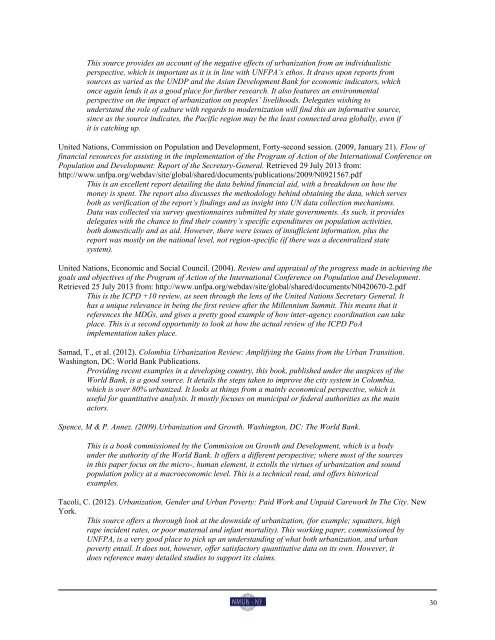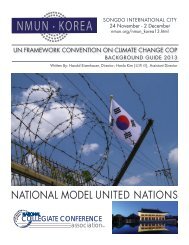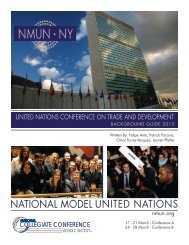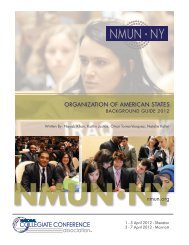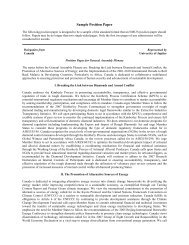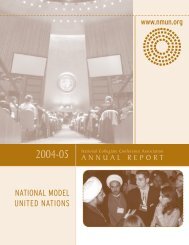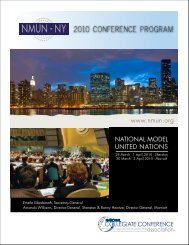UNFPA Background Guide - National Model United Nations
UNFPA Background Guide - National Model United Nations
UNFPA Background Guide - National Model United Nations
You also want an ePaper? Increase the reach of your titles
YUMPU automatically turns print PDFs into web optimized ePapers that Google loves.
This source provides an account of the negative effects of urbanization from an individualistic<br />
perspective, which is important as it is in line with <strong>UNFPA</strong>’s ethos. It draws upon reports from<br />
sources as varied as the UNDP and the Asian Development Bank for economic indicators, which<br />
once again lends it as a good place for further research. It also features an environmental<br />
perspective on the impact of urbanization on peoples’ livelihoods. Delegates wishing to<br />
understand the role of culture with regards to modernization will find this an informative source,<br />
since as the source indicates, the Pacific region may be the least connected area globally, even if<br />
it is catching up.<br />
<strong>United</strong> <strong>Nations</strong>, Commission on Population and Development, Forty-second session. (2009, January 21). Flow of<br />
financial resources for assisting in the implementation of the Program of Action of the International Conference on<br />
Population and Development: Report of the Secretary-General. Retrieved 29 July 2013 from:<br />
http://www.unfpa.org/webdav/site/global/shared/documents/publications/2009/N0921567.pdf<br />
This is an excellent report detailing the data behind financial aid, with a breakdown on how the<br />
money is spent. The report also discusses the methodology behind obtaining the data, which serves<br />
both as verification of the report’s findings and as insight into UN data collection mechanisms.<br />
Data was collected via survey questionnaires submitted by state governments. As such, it provides<br />
delegates with the chance to find their country’s specific expenditures on population activities,<br />
both domestically and as aid. However, there were issues of insufficient information, plus the<br />
report was mostly on the national level, not region-specific (if there was a decentralized state<br />
system).<br />
<strong>United</strong> <strong>Nations</strong>, Economic and Social Council. (2004). Review and appraisal of the progress made in achieving the<br />
goals and objectives of the Program of Action of the International Conference on Population and Development.<br />
Retrieved 25 July 2013 from: http://www.unfpa.org/webdav/site/global/shared/documents/N0420670-2.pdf<br />
This is the ICPD +10 review, as seen through the lens of the <strong>United</strong> <strong>Nations</strong> Secretary General. It<br />
has a unique relevance in being the first review after the Millennium Summit. This means that it<br />
references the MDGs, and gives a pretty good example of how inter-agency coordination can take<br />
place. This is a second opportunity to look at how the actual review of the ICPD PoA<br />
implementation takes place.<br />
Samad, T., et al. (2012). Colombia Urbanization Review: Amplifying the Gains from the Urban Transition.<br />
Washington, DC: World Bank Publications.<br />
Providing recent examples in a developing country, this book, published under the auspices of the<br />
World Bank, is a good source. It details the steps taken to improve the city system in Colombia,<br />
which is over 80% urbanized. It looks at things from a mainly economical perspective, which is<br />
useful for quantitative analysis. It mostly focuses on municipal or federal authorities as the main<br />
actors.<br />
Spence, M & P. Annez. (2009).Urbanization and Growth. Washington, DC: The World Bank.<br />
This is a book commissioned by the Commission on Growth and Development, which is a body<br />
under the authority of the World Bank. It offers a different perspective; where most of the sources<br />
in this paper focus on the micro-, human element, it extolls the virtues of urbanization and sound<br />
population policy at a macroeconomic level. This is a technical read, and offers historical<br />
examples.<br />
Tacoli, C. (2012). Urbanization, Gender and Urban Poverty: Paid Work and Unpaid Carework In The City. New<br />
York.<br />
This source offers a thorough look at the downside of urbanization, (for example; squatters, high<br />
rape incident rates, or poor maternal and infant mortality). This working paper, commissioned by<br />
<strong>UNFPA</strong>, is a very good place to pick up an understanding of what both urbanization, and urban<br />
poverty entail. It does not, however, offer satisfactory quantitative data on its own. However, it<br />
does reference many detailed studies to support its claims.<br />
30


